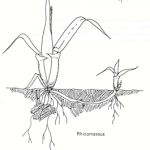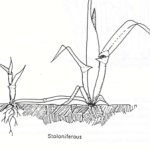Today, in the latest in our series on bowling green performance evaluation we’ll break from the examination of the visual and functional attributes of turf and look a bit more closely at some of the growth characteristics of the grasses we use. The growth habit of any turf grass species plays a big role in its suitability for use in the bowling green setting.
Turf Grass Growth Habit
There are 3 main growth habits we need to consider and these are as follows:
Each of these growth habits can be present in fine turf. Let’s look at them individually:
Bunch Type
Bunch-type turf grasses, spread primarily or exclusively by tillering. Where seeded at sufficient rates, they can form a uniform turf. However, at low seeding rates where growth proceeds from isolated individual plants, small clumps develop, resulting in a non-uniform surface. Clumpiness in a turf is characteristic of a perennial ryegrass, Chewings fescue, annual meadow grass and other bunch-type turf grasses.
Although some of the finer grasses such as Chewings fescue have bunch type characteristics, they are usually mixed with other spreading types (such as as slender creeping red fescue) in order to achieve a dense and uniform turf surface.
Rhizomatous
Rhizomatous turf grasses spread by below ground shoots called rhizomes. Because of the emergence of rhizome terminals at positions away from the mother plant, strongly rhizomatous turf grasses tend to form uniform turf with aerial shoots orientated in more or less upright position. Difference in stem elongation and leaf orientation among cultivars influence turf grass quality and close-mowing tolerance. Common turf grass species are Smooth Stalked Meadowgrass, Creeping Red Fescue and in the warm season zone, Seashore Paspallum.
Stoloniferous
Stoloniferous turf grasses spread above ground using lateral shoots called stolons. Turfs formed from stoloniferous turf grasses may appear to have aerial shoots orientated in a predominantly decumbent position. Creeping bentgrass sustained at relatively high mowing heights (7 mm – ¾ in) forms a distinctly grainy turf with most shoots growing horizontally. We call this, lateral growth, and the effect on turf is called grain, which can have a strong influence on green speed and trueness.
Conclusion
The varying growth habits of our turf grasses can bring both benefits and further challenges. This weekend, can you take time to look at your green to see if you can identify any of these growth habits in your turf? One that is most easily spotted is annual meadow grass which is a bunch type and creates distinctive light green clumps in many bowling greens.
Series
This is the 5th part in a series of short articles which aims to give you the tools to make a performance evaluation of your bowling green. You can access the previous articles in this series are as follows:
Part 1. The Performance Evaluation of the Bowling Green
Next time we’ll finish up on our visual clues before delving into the functional measurements we can make in our continued evaluation of the performance of the bowling green.




